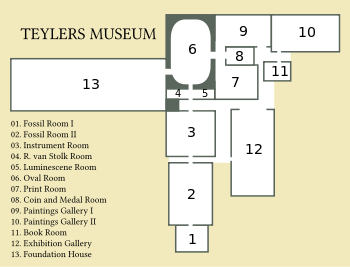Name
| Year
| Maker
| Image |
|---|
| Astronomical time-keeper | | Andreas Hohwü |  |
| Sound analyser with 8 resonator balls | 1860s | Rudolph Koenig |  |
| Synthesizer | 1865 | after Hermann von Helmholtz by Koenig |  |
| Synthesizer after Helmholtz | 1865 | after Helmholtz by Koenig |  |
| Wire cable display case | | Guglielmo Marconi |  |
| Cabinet I: thermometry heat conduction | | |  |
| Cabinet I | | |  |
| Cabinet II - measuring instruments (lower shelf) | | |  |
| Polytrope | | G.E. Sire |  |
| Cabinet III: electricity | | |  |
| Cabinet III | | |  |
| Cabinet III | | |  |
| Cabinet III | | |  |
| Cabinet III | | |  |
| Cabinet III | | |  |
| absolute electrometer | 1883 | Thomson by Breguet |  |
| Conductors (isolated with glass) to demonstrate the strength of electric charges don't depend on sphere size | 1840 | |  |
| small cylinder electrostatic generator | 1856 | Jean Claude Eugène Péclet |  |
| 1860 spark measurer and 1865 discharger for spectroscope | 1860-5 | |  |
| gold leaf electrometer | 1866 | |  |
| induction machine | 1888 | James Wimshurst |  |
| electroscope | 1912 | Franz S. Exner |  |
| spark duration demonstrator | 1859 | |  |
| electroscope | 1870 | |  |
| discharge points | 1890 | |  |
| The small electricity machine developed by Martin van Marum as a student | | Gerhard Kuyper |  |
| Cabinet IV: Telegraphy | | |  |
| commutator for Telegraph | 1865 | |  |
| contact breaker | 1865 | |  |
| philips lightbulbs | | |  |
| Wireless telegraphy receiver | 1897 | Guglielmo Marconi |  |
| Cabinet V: geomagnetics and Geissler | | |  |
| Gas discharge tube with holder by Ducretet and Lejeune | 1862 | Heinrich Geißler |  |
| Universal geomagnetic instrument | 1877 | after Moritz Meyerstein & Henry Barrow |  |
| X-ray tube | 1930 | |  |
| Cabinet VII: optics | | |  |
| reading telescopes | 1865 | Carl August von Steinheil |  |
| uranium glass objects 1861 and photometer 1870 | 1861-1870 | |  |
| Cabinet VIII: acoustics | | |  |
| Cabinet VIII - sound | | |  |
| Cabinet VIII - sound | | |  |
| Cabinet VIII - sound | | |  |
| Cabinet IX - sound | | |  |
| Cabinet IX - sound | | |  |
| Cabinet IX | | |  |
| Graphophone by Columbia Phonograph Company | 1897 | CBC |  |
| Three almost identical telephone sets after Bell end of 19th century | c.1880 | Alexander Graham Bell |  |
| Cabinet X: Heat, carbon arc lamps | | |  |
| Cabinet X | | |  |
| galvanometer | | Leopoldo Nobili |  |
|




















































